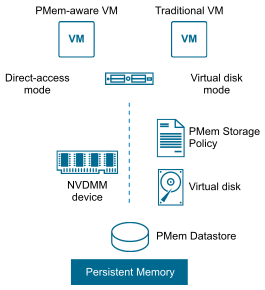ESXi supports next generation persistent memory devices, also known as Non-Volatile Memory (NVM) devices. These devices combine performance and speed of memory with the persistence of traditional storage. They can retain stored data through reboots or power source failures.
Virtual machines that require high bandwidth, low latency, and persistence can benefit from this technology. Examples include VMs with acceleration databases and analytics workload.
To use persistent memory with your ESXi host, you must be familiar with the following concepts.
- PMem Datastore
-
After you add persistent memory to your
ESXi host, the host detects the hardware, and then formats and mounts it as a local PMem datastore.
ESXi uses VMFS-L as a file system format. Only one local PMem datastore per host is supported.
Note: When you manage physical persistent memory, make sure to evacuate all VMs from the host and place the host into maintenance mode.
- PMem Access Modes
- ESXi exposes persistent memory to a VM in two different modes. PMem-aware VMs can have direct access to persistent memory. Traditional VMs can use fast virtual disks stored on the PMem datastore.
- Direct-Access Mode
- In this mode, a PMem region can be presented to a VM as a virtual non-volatile dual in-line memory module (NVDIMM) module. The VM uses the NVDIMM module as a standard byte-addressable memory that can persist across power cycles.
- Virtual Disk Mode
- This mode is available to any traditional VM and supports any hardware version, including all legacy versions. VMs are not required to be PMem-aware. When you use this mode, you create a regular SCSI virtual disk and attach a PMem VM storage policy to the disk. The policy automatically places the disk on the PMem datastore.
- PMem Storage Policy
- To place the virtual disk on the PMem datastore, you must apply the host-local PMem default storage policy to the disk. The policy is not editable.
The following graphic illustrates how the persistent memory components interact.

For information about how to configure and manage VMs with NVDIMMs or virtual persistent memory disks, see the vSphere Resource Management documentation.